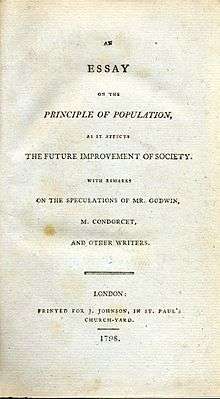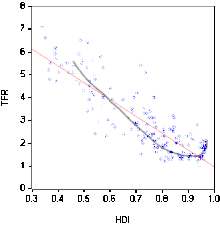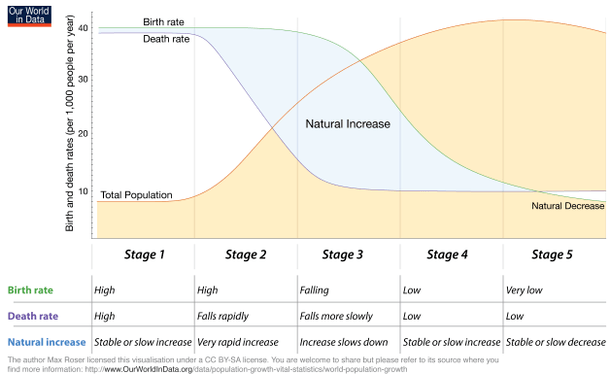Income and fertility

Income and fertility is the association between monetary gain on one hand, and the tendency to produce offspring on the other. There is generally an inverse correlation between income and fertility within and between nations. The higher the degree of education and GDP per capita of a human population, subpopulation or social stratum, the fewer children are born in any industrialized country.[3] In a 1974 UN population conference in Bucharest, Karan Singh, a former minister of population in India, illustrated this trend by stating "Development is the best contraceptive."[4] Many countries are experiencing a rather weak correlation with income and fertility within a given household. Families with a higher income produce a lower number of children resulting in a low fertility rate whereas families with lower income produce more children with a higher fertility rate.[5] Total fertility rate is specifically the number of children who would be born per woman if she were to pass through the childbearing years bearing children according to a current schedule of age-specific fertility rates.[6] In developing or less developed countries, families need their children for labor and for economic support in the future. Many countries do not have proper pension policies, children are needed in order for the parents to have financial support in their old age.
Paradox

The inverse relationship between income and fertility has been termed a demographic-economic paradox. Thomas Malthus, in his book An Essay on the Principle of Population, proposed that greater means (higher income) would enable the production of more offspring (a higher fertility rate). However, roughly speaking, nations or subpopulations with higher GDP per capita are observed to have a lower fertility rate (see the chart). This is the paradox.[7]
Malthus held that in order to prevent widespread suffering, from famine for example, what he called "moral restraint" (which included abstinence) was required. The demographic-economic paradox suggests that reproductive restraint arises naturally as a consequence of economic progress.
Scientist called it the "demographic economic paradox" for at which if you could afford more children, then why would not you have them. There is a list that goes on and on for the specific causes, but five are mentioned below:
- Women are more likely to be independent and not rely on others; therefore, if they make their own decisions, then they often want to have fewer children, and a career.
- With the rate of people going further into education and school, this allows people to obtain more education in that postpones the start of families.
- Many individuals are moving from rural areas into the city live so that families do not have to do intensive agricultural labor work.
- Lessened childhood mortality in wealthier societies means that not as many children are dying at a young age, and therefore the imperative to have more children is reduced.
- The rate of public health is improving and leads to a longer life expectancy. This ultimately means that fewer individuals are needed to do society work.[8]

Overall, women are educated and therefore decide to pursue a career instead of having many children. Economic growth results in greater spending power in the areas of health, housing, nutrition, and education which further reduces the fertility rate.[9]
Thomas Robert Malthus was born at Dorking, a place near London in the year of 1766. He was a student of the Enlightenment movement, who studied at Cambridge.[10]
Individual level observances
In the years after the revolutions of 1989 in Russia, people who were more affected by labour market crises seemed to have a higher probability of having another child than those who were less affected.[11]
Causes and related factors
Coale's Three Preconditions for Decline in Fertility comes from the saying ready, willing and able. Society changes that induce fertility declines may also induce fertility declines, but they will do so only if three preconditions are met: ready, willing and able. A person and the population must have a reason to want to limit fertility. If people have economic and social opportunities that make it advantageous to limit fertility they will be more willing to limit it. There must be economic and psychosocial costs involved such as the cost of birth control or abortions.[12]
It is hypothesized that the observed trend in many countries of having fewer children has come about as a response to increased life expectancy, reduced childhood mortality, improved female literacy and independence, and urbanization that all result from increased GDP per capita,[13] consistent with the demographic transition model. The increase in GDP in Eastern Europe after 1990 has been correlated with childbearing postponement and a sharp decline in fertility.[14]
When looking at an individual level in advanced countries where birth control is the norm, increased income is likewise associated with decreased fertility. Theories behind this include:
- People earning more have a higher opportunity cost if they focus on childbirth and parenting rather than their continued career[14]
- Women who can economically sustain themselves have less incentive to become married.[14]
- Higher-income parents value quality over quantity and so spend their resources on fewer children.[14]
Religion sometimes modifies the effect; higher income is associated with slightly increased fertility among Catholic couples but associated with slightly decreased fertility among Protestant couples.[15]
Gross domestic product stands for GDP, which is the total dollar value of all goods an economy produces over a given time usually expressed as a comparison to the previous quarter or year. If the year to year GDP is up 5 percent, then the economy has grown 5 percent. Income approach, adding up all earnings over a year, or add up what everyone spent, which is called the expenditures method. The income approach is described as the total employee compensation, gross profit for corporations and non-incorporated firms, and taxes minus subsidies. The expenditures method is more common and it specifically combines total consumption within households, and the total investment within a business. It also reveals how much money the government is spending and the balance of trade. Another factor by which is not promptly supportive are the youngsters who play a role within GDP. They clearly do not add to it and do not help the stock and bond market returns. Youngsters are wellsprings of advancement, entrepreneurial souls and play a major incentive to GDP.[16]
It is argued then that the poorer individuals have fewer children so that they can obtain more of other types of consumer goods. The wealthier, on the other hand, are able to obtain the consumer goods which they desire as well as to have more children. Generally, Developed country countries have a lower fertility rate while a less economic developed country has a higher fertility rate. You will find that in Japan a more developed country, the GDP of $32,600 in 2009 was 1.22 children born per woman. But in Ethiopia a GDP of $900 in 2009 was 6.17 children born per woman.[17] The reason for more developed countries to have a lower fertility rate is because of the high standard of living which is expensive and in order to achieve that, they focus more on education rather than having a large family. Educated women and low mortality rate for children equals a smaller family and more self-centered people.
The United States Census Bureau is a fundamental and critical data collection tool that is used specifically in demography. Censuses are a count of the population and not considered a sample. Since the end of World War II, the United Nations has encouraged all countries to take a census.
Another way to look at it is through the demographic transition model to which was designed in 1929 by demography Warren Thompson who classified countries into three major groups. Number one being high births rates and high but declining death rates, number two was the decline of birth rates and death rates (death rates dealing faster) and number three was the rapid decline in birth death rates (birth rates decline faster).
Consequences
Across countries, there is a strong negative correlation between Gross domestic product and fertility, and ultimately it is proven that a strong negative correlation between household income and fertility.
A reduction in fertility can lead to an aging population, which leads to a variety of problems. See for example the Demographics of Japan.
A related concern is that high birth rates tend to place a greater burden of child rearing and education on populations already struggling with poverty. Consequently, inequality lowers average education and hampers economic growth.[18] Also, in countries with a high burden of this kind, a reduction in fertility can hamper economic growth as well as the other way around.[19] Richer countries have a lower fertility rate than poorer ones, and high income families have fewer kids than low-income ones.[20]
Contrary findings
A United Nations report in 2002 came to the conclusion that sharp declines in fertility rates in India, Nigeria, and Mexico occurred despite low levels of economic development.[21]
Every country could differ in their respective relationship between income and fertility. Some countries show that income and fertility are directly related but other countries show a directly inverse relationship.[22]
Increased unemployment is generally associated with lower fertility.[14] A study in France came to the result that employment instability has a strong and persistent negative effect on the final number of children for both men and women and contributes to fertility postponement for men. It also came to the result that employment instability has a negative influence on fertility among those with more egalitarian views about the division of labor but still a positive influence for women with more traditional views.[23]
Fertility declines have been seen during economic recessions. This phenomenon is seen as a result of pregnancy postponement, especially of first births. However, this effect can be short-term and largely compensated for during later times of economic prosperity.[14]
Fertility J-curve
Some scholars have recently questioned the assumption that economic development and fertility are correlated in a simple negative manner. A study published in Nature in 2009 found that when using the Human Development Index instead of the GDP as measure for economic development, fertility follows a J-shaped curve: with rising economic development, fertility rates indeed do drop at first but then begin to rise again as the level of social and economic development increases while still remaining below the replacement rate[7][24]

In an article published in Nature, Myrskylä et al. pointed out that “unprecedented increases” in social and economic development in the 20th century had been accompanied by considerable declines in population growth rates and fertility. This negative association between human fertility and socio-economic development has been “one of the most solidly established and generally accepted empirical regularities in the social sciences”.[24] The researchers used cross-sectional and longitudinal analyses to examine the relationship between total fertility rate (TFR) and the human development index (HDI).
The main finding of the study was that, in highly developed countries with an HDI above 0.9, further development halts the declining fertility rates. This means that the previously negative development-fertility association is reversed; the graph becomes J-shaped. Myrskylä et al. contend that there has occurred “a fundamental change in the well-established negative relationship between fertility and development as the global population entered the twenty-first century”.[24]
Some researchers doubt J-shaped relationship fertility and socio-economic development (Luci and Thevenon, 2010;[25] Furuoka, 2009). For example, Fumitaka Furuoka (2009) employed a piecewise regression analysis to examine the relationship between total fertility rate and human development index. However, he found no empirical evidence to support the proposition that advances in development are able to reverse declining fertility rates.
More precisely, the empirical findings of Furuoka’s 2009 study indicate that in countries with a low human development index, higher levels of HDI tend to be associated with lower fertility rates. Likewise, in countries with a high human development index, higher levels of HDI are associated with lower fertility rates, although the relationship is weaker. Furuoka's findings support the "conventional wisdom" that higher development is consistently correlated with lower overall fertility.[26]
See also
References
- ↑ "Field Listing: Total Fertility Rate". The World Factbook. Retrieved 2016-04-24.
- ↑ "Country Comparison: GDP - Per Capita (PPP)". The World Factbook. Retrieved 2016-04-24.
- ↑ Vandenbroucke, Guillaume (December 13, 2016). "The Link between Fertility and Income". Federal Reserve Bank of St Louis (USA).
- ↑ Weil, David N. (2004). Economic Growth. Addison-Wesley. p. 111. ISBN 0-201-68026-2.
- ↑ "How Income Affects Fertility". Institute for Family Studies. Retrieved 2018-03-28.
- ↑ "Population Handbook – Population Reference Bureau". www.prb.org. Retrieved 2018-03-28.
- 1 2 "The best of all possible worlds? A link between wealth and breeding". The Economist. August 6, 2009.
- ↑ "How Income Affects Fertility". Institute for Family Studies. Retrieved 2018-03-29.
- ↑ Staff, Investopedia (2005-02-08). "Economic Growth". Investopedia. Retrieved 2018-04-09.
- ↑ "Thomas Robert Malthus: The Concise Encyclopedia of Economics | Library of Economics and Liberty". www.econlib.org. Retrieved 2018-03-28.
- ↑ Kohler H.P.; Kohler, I. (2002). "Fertility Decline in Russia in the Early and Mid 1990s: The Role of Economic Uncertainty and Labour Market Crises" (PDF). European Journal of Population.
- ↑ van de Kaa, Dirk J. (2004). "["Ready, Willing, and Able": Ansley J. Coale, 1917-2002]". The Journal of Interdisciplinary History. 34 (3): 509–511. JSTOR 3657089.
- ↑ Montgomery, Keith, The demographic transition, University of Wisconsin-Marathon County, archived from the original on 18 October 2012
- 1 2 3 4 5 6 Balbo, Nicoletta; Billari, Francesco C.; Mills, Melinda (2012). "Fertility in Advanced Societies: A Review of Research". European Journal of Population / Revue européenne de Démographie. 29: 1. doi:10.1007/s10680-012-9277-y.
- ↑ Charles F. Westoff; R. G. Potter (2015). Third Child: A Study in the Prediction of Fertility. Princeton University Press. ISBN 9781400876426. Page 238
- ↑ Weeks, John (2014). Population: An Introduction to Concepts and Issues, Twelfth Edition.
- ↑ "Ethiopia" (PDF). A Country Status Report on Health and Poverty (In Two Volumes) The World Bank Group Africa Region Human Development & Ministry of Health, Ethiopia. II: Main Report. July 2005.
- ↑ de la Croix, David; Doepcke, Matthias (2003). "Inequality and growth: why differential fertility matters" (PDF). American Economic Review. 4: 1091–1113.
- ↑ UNFPA: Population and poverty. Achieving equity, equality and sustainability. Population and development series no. 8, 2003.
- ↑ STANFORD, J. B., & SMITH, K. R. (2013). "MARITAL FERTILITY AND INCOME: MODERATING EFFECTS OF THE CHURCH OF JESUS CHRIST OF LATTER-DAY SAINTS RELIGION IN UTAH". Journal of Biosocial Science, 45(2), 239-48.
- ↑ Maria E. Cosio-Zavala (2002). "Examining Changes in the Status of Women And Gender as Predictors Of Fertility Change Issues in Intermediate-Fertility Countries
Part of: Completing the Fertility Transition" (PDF). United Nations, Department of Economic and Social Affairs Population Division. - ↑ Hutzler, S.; Sommer, C.; Richmond, P. (2016). "On the relationship between income, fertility rates and the state of democracy in society". Physica A: Statistical Mechanics and its Applications. 452: 9. Bibcode:2016PhyA..452....9H. doi:10.1016/j.physa.2016.02.011.
- ↑ Daniel Ciganda (2015). "Unstable work histories and fertility in France: An adaptation of sequence complexity measures to employment trajectories". Demographic Research.
- 1 2 3 Myrskylä, Mikko; Kohler, Hans-Peter; Billari, Francesco C. (2009). "Advances in development reverse fertility declines". Nature. 460 (7256): 741. Bibcode:2009Natur.460..741M. doi:10.1038/nature08230. PMID 19661915.
- ↑ Luci, A; Thvenon, O (2010). "Does economic development drive the fertility rebound in OECD countries?". Paper presented in the European Population Conference 2010 (EPC2010), Vienna, Austria, September 1–4, 2010.
- ↑ Fumitaka Furuoka (2009). "Looking for a J-shaped development-fertility relationship: Do advances in development really reverse fertility declines?". Economics Bulletin. 29: 3067–3074.
External links
- Macleod, Mairi (29 October 2013), Population paradox: Why richer people have fewer kids (2940), New Scientist



